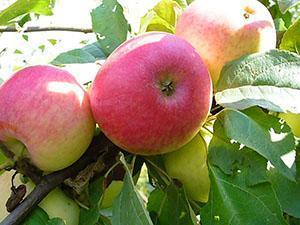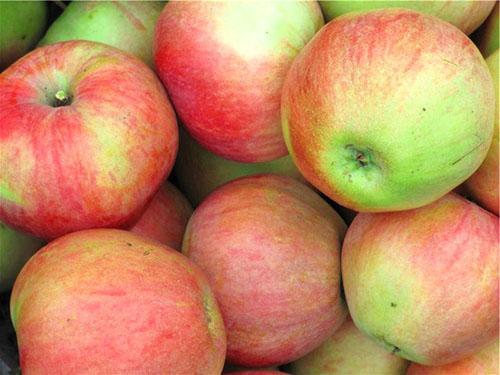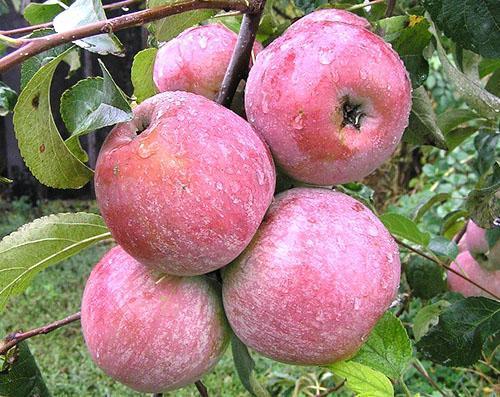Meet the time-tested summer variety of the Medunitsa apple tree
 The result of many years of work by the Soviet school of breeders has become dozens of magnificent varieties, which, even after so many years, are loved and in demand by gardeners. The apple tree Medunitsa appeared in 1935 thanks to the efforts of the famous scientist S.I. Isaev, who chose the Welsey variety, of Canadian origin, and the native Russian Cinnamon striped variety for crossing.
The result of many years of work by the Soviet school of breeders has become dozens of magnificent varieties, which, even after so many years, are loved and in demand by gardeners. The apple tree Medunitsa appeared in 1935 thanks to the efforts of the famous scientist S.I. Isaev, who chose the Welsey variety, of Canadian origin, and the native Russian Cinnamon striped variety for crossing.
Medunitsa not only absorbed the best qualities of the parent plants, but also for a long time became a leader among Russian summer varieties.
Description and photo of the apple tree Medunitsa

The crop has outstanding winter hardiness and a yield of up to 180 kg of fresh fruits from a tree per season. Young apple trees of Medunitsa give yields annually, but as they mature, abundant fruiting is expected to wait only in a year. At the same time, trees and fruits are rarely affected by one of the most common diseases of fruit trees - scab, the variety is resistant to rot and is not too sensitive to the height of groundwater.
In central Russia, apples on Medunitsa ripen by mid-August and without losing their presentation and quality can be transported and stored for about a month. When cooled, the fruit can remain unharmed for up to 4–5 months.
 The fruits themselves, according to the description and photo of the Medunitsa apple tree, are medium-sized and weigh on average from 100 to 150 grams. According to experts, the taste of light or creamy juicy pulp of Lungwort apples was rated 4.3 points. And due to the high, up to 14%, sugar content and an extremely small amount of acids in fruits, still unripe fruits are often eaten.
The fruits themselves, according to the description and photo of the Medunitsa apple tree, are medium-sized and weigh on average from 100 to 150 grams. According to experts, the taste of light or creamy juicy pulp of Lungwort apples was rated 4.3 points. And due to the high, up to 14%, sugar content and an extremely small amount of acids in fruits, still unripe fruits are often eaten.
But only when fully ripe, you can enjoy a truly honey, even slightly spicy aroma and sweetness of flat-round yellow-green apples with a deep red striped or speckled blush that occupies up to half of the fruit surface.
Planting and caring for the Medunitsa apple tree
Like most fruit trees, Medunitsa needs a well-lit area with neutral or slightly acidic loose soil that can support the growth and fruiting of this tall variety.
 If the lack of moisture and modest soil fertility for trees can be compensated for by caring for an apple tree, artificial watering and top dressing, then they react to the lack of sunlight by reducing the number of fruits, reducing their quality and lower sugar content. For the Medunitsa apple tree, it is important to choose a place where the tree will not suffer from stagnant water in the ground. The most suitable soils for growing apple trees can be considered loose loam, sandy loam, floodplain soil, as well as chernozems of the forest-steppe zone. On sandy soil, apple trees require more fertilization than usual and regular watering.
If the lack of moisture and modest soil fertility for trees can be compensated for by caring for an apple tree, artificial watering and top dressing, then they react to the lack of sunlight by reducing the number of fruits, reducing their quality and lower sugar content. For the Medunitsa apple tree, it is important to choose a place where the tree will not suffer from stagnant water in the ground. The most suitable soils for growing apple trees can be considered loose loam, sandy loam, floodplain soil, as well as chernozems of the forest-steppe zone. On sandy soil, apple trees require more fertilization than usual and regular watering.
The technology of organizing a planting pit and planting an apple-tree seedling in the ground does not have any peculiarities. Before planting by the tree, you can:
- remove most of the foliage, leaving only a few leaves at the tops of the shoots;
- carry out the first formative pruning;
- when immersing an apple tree seedling in a hole, spread all the roots.
 This will have a positive effect on the rate of rooting of the plant and the beginning of its active growth. The main thing is that the root collar of the plant is not buried, and after filling with the soil mixture, it remains above ground level. Apple tree care begins from the moment of planting. Since in the first year after planting the apple tree of Medunitsa has not yet recovered from acclimatization and is weak for fruiting, it is better to remove all formed flower buds. So, an apple tree seedling will take root better and faster.
This will have a positive effect on the rate of rooting of the plant and the beginning of its active growth. The main thing is that the root collar of the plant is not buried, and after filling with the soil mixture, it remains above ground level. Apple tree care begins from the moment of planting. Since in the first year after planting the apple tree of Medunitsa has not yet recovered from acclimatization and is weak for fruiting, it is better to remove all formed flower buds. So, an apple tree seedling will take root better and faster.
 In the next few years, it is imperative to normalize the harvest, partially breaking off the ovary, which has reached the size of a five-ruble coin. The remaining fruits will not only be larger and sweeter, a small amount of them will help the tree better prepare for the winter period.
In the next few years, it is imperative to normalize the harvest, partially breaking off the ovary, which has reached the size of a five-ruble coin. The remaining fruits will not only be larger and sweeter, a small amount of them will help the tree better prepare for the winter period.
On adult apple trees of Medunitsa, normalization makes it possible to somewhat level the decline in yield the next year after abundant fruiting.
To protect the trunk of a recently planted tree from frost, when the snow cover has not yet established, the trunk circle is densely covered with mulch from humus, needles, sawdust or foliage. The stem itself is also insulated and protected from pests with the help of materials that can survive the cold and allow air to pass through well.
Watering and feeding apple trees in summer and spring
 For abundant fruiting and growth, an apple tree, depending on the characteristics of growth and rootstock, requires a different amount of nutrients and moisture. Vigorous species, including Medunitsa, get food from an area of 20 to 25 square meters, and apple trees and dwarf varieties only from 9 to 10. In any case, regular fertilization is indispensable:
For abundant fruiting and growth, an apple tree, depending on the characteristics of growth and rootstock, requires a different amount of nutrients and moisture. Vigorous species, including Medunitsa, get food from an area of 20 to 25 square meters, and apple trees and dwarf varieties only from 9 to 10. In any case, regular fertilization is indispensable:
- The first feeding is carried out in the spring. 30-40 grams of ammonium nitrate and the same amount of nitroammophoska are added to the soil.
- During the period when the ovary begins to form on the apple trees of Medunitsa, the plants should receive 120-145 grams superphosphate, from 8 to 10 kg of humus, rotted compost and about 45–55 grams of potassium chloride per tree.
Top dressing of apple trees in summer consists in two or three times the introduction of 2-3 buckets of liquid nitrogen-containing fertilizers, which can be used as an aqueous infusion of humus, chicken droppings or manure.
 Fruit trees respond well to watering near-trunk circles with infusion of nettle, celandine and other plants, as well as making a couple of handfuls wood ash... It should only be remembered that fertilizing containing nitrogen is stopped by the middle of summer, so as not to provoke the growth of new shoots, which will not have time to get stronger and mature by winter.
Fruit trees respond well to watering near-trunk circles with infusion of nettle, celandine and other plants, as well as making a couple of handfuls wood ash... It should only be remembered that fertilizing containing nitrogen is stopped by the middle of summer, so as not to provoke the growth of new shoots, which will not have time to get stronger and mature by winter.
During the entire growing season, the soil under the crowns of Medunitsa apple trees should remain loose, for which both soil loosening and a 5-cm layer of mulch are used, which allows air to pass through, but retains moisture evaporation. The Medunitsa apple tree care program includes weekly watering of trees at the rate of 10-18 liters per tree. It is especially important that the plant does not need moisture during the pouring of fruits, from July until the end of fruiting. During this period, not only honey apples ripen, but also the laying of flower buds of the next year takes place.
In August, watering is limited and regulated depending on the weather, making sure that the soil under the crown does not dry out.
Features and diagram of the formation of the apple tree crown
 Rather tall trees of the Medunitsa apple tree stand out with a wide pyramidal crown shape. In this case, not very many shoots are formed, and the main fruiting occurs on the branches of two years and older. Most of the ovary of Medunitsa is formed on the ringlets, and only a small number of apples produce fruit rods. Therefore, the formation of the crown of the apple tree, continuing until the age of 12, according to the scheme, provides for both thinning of excess branches and shortening of shoots.
Rather tall trees of the Medunitsa apple tree stand out with a wide pyramidal crown shape. In this case, not very many shoots are formed, and the main fruiting occurs on the branches of two years and older. Most of the ovary of Medunitsa is formed on the ringlets, and only a small number of apples produce fruit rods. Therefore, the formation of the crown of the apple tree, continuing until the age of 12, according to the scheme, provides for both thinning of excess branches and shortening of shoots.
At this time, it is important that the apple tree has an actively growing guide and skeletal branches subordinate to it. When the Medunitsa apple tree reaches a height of 2.5 to 3 meters, vertical growth is limited by cutting off the upper part of the guide above a strong lateral branch. From this point on, the main task of pruning is:
- prevention of excessive crown density;
- removal of tops;
- maintaining the sanitary condition of the tree.
 When the yield of an adult tree begins to fall, the ovaries are concentrated mainly in the upper part of the crown, and the growth of one-year-old shoots is limited to 20-30 cm, you need to think about rejuvenating pruning of the Medunitsa apple tree.
When the yield of an adult tree begins to fall, the ovaries are concentrated mainly in the upper part of the crown, and the growth of one-year-old shoots is limited to 20-30 cm, you need to think about rejuvenating pruning of the Medunitsa apple tree.
In early spring, before the buds awaken above the lateral branch, the bare skeletal branches are cut off, the place of the saw cut is carefully processed with pitch. This technique induces an influx of nutrients and the awakening of dormant kidneys.
 As a result, in the same season, the crown section gives several new shoots, of which no more than 4 of the most powerful should be left. On their basis, the formation of the crown of the apple tree and the side branches will again be carried out according to the scheme. Tops can also be used as replacement shoots, often forming just on branches that are losing their strength and ability to bear fruit. And so that pruning does not weaken the tree, it is better to remove large branches not in one season, but in two years.
As a result, in the same season, the crown section gives several new shoots, of which no more than 4 of the most powerful should be left. On their basis, the formation of the crown of the apple tree and the side branches will again be carried out according to the scheme. Tops can also be used as replacement shoots, often forming just on branches that are losing their strength and ability to bear fruit. And so that pruning does not weaken the tree, it is better to remove large branches not in one season, but in two years.